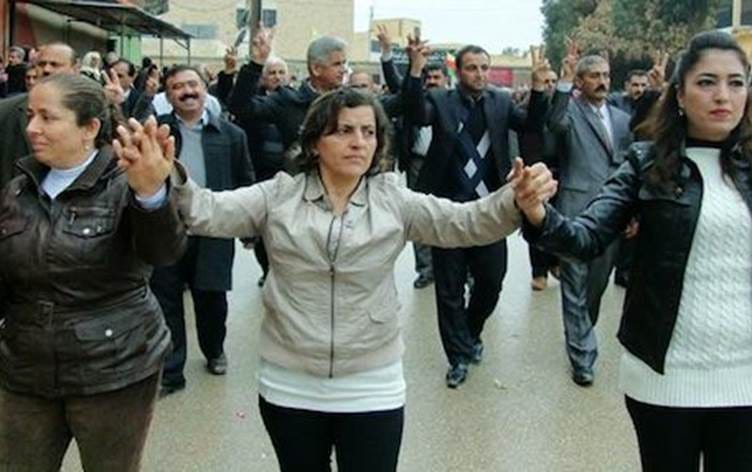The Alevis (not Alawis) of Afrin
Background information on Syria's only Kurdish Alevi community
This is an edited version of a Twitter thread I published in 2020 covering Afrin’s Alevi minority. Given the obscurity of the topic and the increasingly uselessness of Twitter for finding and publishing information it seems worthwhile to upload it in article form here. While most of it is background, the portion covering events since Turkey’s 2018 invasion of Afrin is five years out of date and is a topic that deserves a returning to. I have not followed the situation of Afrin’s Alevis closely since this period, but it probably has not differed greatly from that of Afrin’s Ezidi population.
Many but not all Afrini Ezidis fled the region in the face of the Turkish takeover, which was immediately followed by acts of desecration targeting Muslim, Ezidi, and Alevi shrines - partially out of sectarian animus and Salafi-influence theological opposition to such sites, and partially out of the belief that these shrines contained hidden valuables. During the ensuing years reports of kidnappings and forced conversions continued, though the local community did become more visible and likely grew due to increasing numbers of returnees. It was highlighted in Turkish media several times beginning around late 2020 and by 2024 had begun putting on public celebrations of Çarşema Sor, Ezidi New Year, in the region (by comparison see this 2022 video of small, private celebration mostly featuring a handful of older men). Anyway, this extrapolation is a placeholder until new work is published covering the Afrini Alevis.
After Ezidis, Alevis have historically made up the second largest religious minority within the Afrin district of Aleppo, primarily populated by Sunni Kurds. Alevism generally refers to a fairly diverse heterodox offshoot of Shi‘a Islam found mostly in Turkey that includes both Turkish and Kurdish variants. While both names refer to the cousin of the Prophet Muhammad Ali ibn Abi Talib and are spelled the same way in Arabic (علويّ) and Kurmanci Kurdish (Elewî), Alevism is doctrinally and genealogically distinct from the ‘Alawi faith practiced by Arabs in coastal Syria and the adjacent Turkish province of Hatay. This community highlighted represents the only Alevi community within Syria.
The Alevis of Afrin are Kurdish-speakers with geographical origins lying to the north in present day Turkey. Pre-war population estimates put the adherents of this syncretic Shi'a-linked faith between 5-15k, almost all of whom resided in the town of Mabeta/Ma'batli and nearby hamlets (see dashcam tour of Mabeta below) located in the center of the Afrin district.
Given their size and historically self-guarded way of life little has been written on them. Accounts given by some community members trace their arrival in the area to sixteenth century persecution to the north perpetrated by Ottoman Sultan Selim I against Alevis, compelling them to seek refuge in this hilly landscape between the cities of Antep and Aleppo.
It appears that since then Alevis from further north, presumably Kurmanci rather than Zaza speakers, have continued to disembark for the area, fleeing periodic bouts of violence carried out by neighboring Sunnis, the Ottoman state and later, the Turkish Republic. In reference to Kurdish-speaking Alevis, Van Bruinessen (1997) writes of a “series of enclaves [that] stretches south, through Malatya, Elbistan (in Maraş) and Antep to Syria and Adana…some of these communities…served by seyyids of lineages based in Dersim.”
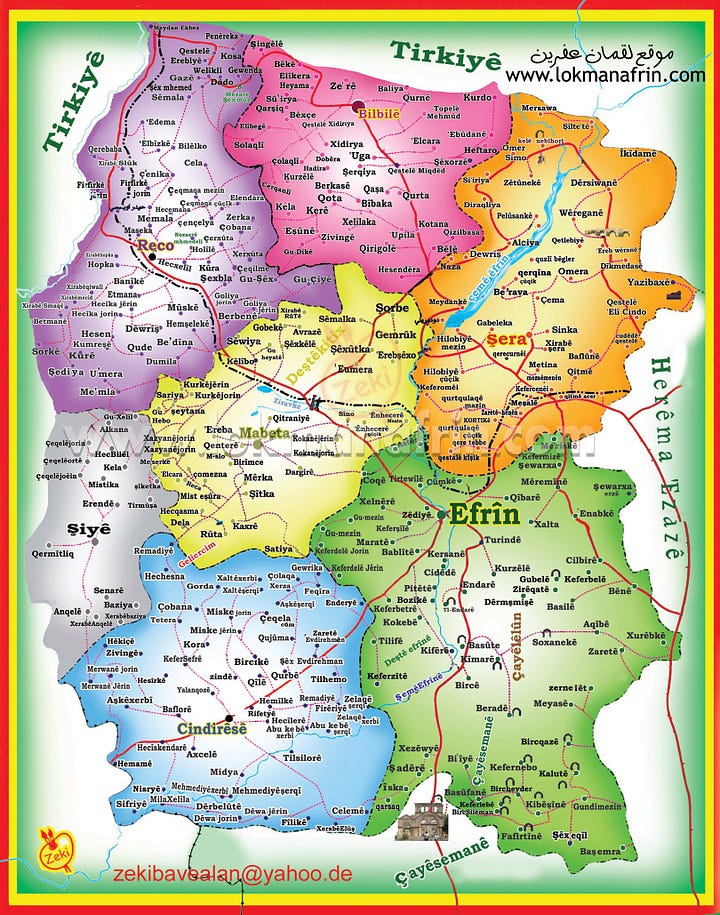
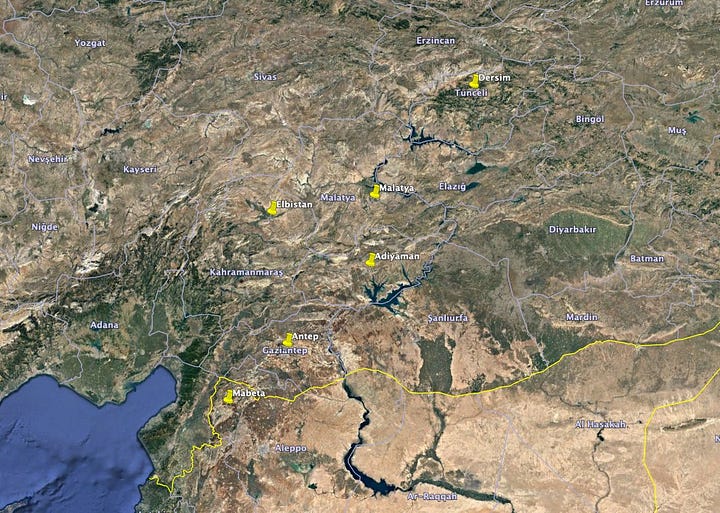
This Dersimi heritage is corroborated by locals, whose accounts also refer to Malatya, Elbistan and Adıyaman as geographic origins of their families. The last wave of Alevi refugees arrived in Afrin fleeing the Dersim massacres carried out by the Turkish state in 1938. The most notable Dersim native who ended up in Afrin was Dr. Nuri Dersimi, a leader of the failed Koçgiri rebellion of 1921 and founding member of the early Kurdish nationalist Xoybûn League who fled Turkey in 1937. Dersimi died in 1973 and is buried in Afrin’s Hannan cemetery (photos of Dersimi and his family, and his grave below).


While the isolated nature of the Kurd Dagh (Ottoman name for the Afrin region meaning 'Mountain of the Kurds') offered Alevis relative protection they still faced occasional violence and persecution from local Kurdish Sunni populations. According to local historian Dr. Muhammed Abdo Ali, the most recent such incidents occurred in 1920. In the following decade Afrini Alevis were also subjected to sectarian harassment from the Muroud movement, headed by a Naqshbandi sheikh. More on the Muroud can be found in Allsopp (2015), who focuses on its economic populism directed at local landowning elite.
While Syria's northern border was formed by the French and Turkish republic in 1921, it appears to have remained rather porous for some time. This can be seen in the case of Dersimi refugees as well as Alevi pirs & sheikhs yearly visits south to perform religious duties. Border fluidity would end in Syria's post-colonial era as tensions with Turkey steadily increased. This severed the Afrini Alevi from family and religious leadership north of the border. Locals have attributed this to a decline in Alevi practice amongst community members. Important parts of the faith, such as the practice of endogamy, became harder and harder to practice. ‘Baba Sha‘abo,’ the main Alevi religious authority in Afrin, died in the 1980s and his position remained empty for some time given lack of access to religious training.
These developments were compounded by increasing Arabizing policy from Damascus, targeting Syria's Kurdish-speaking population. This did, however, appear to create greater cross-sect Kurdish solidarity, as Maisel (2017) notes occurring amongst Syrian Ezidis as well.
Due to fears of sectarian violence, worship ceremonies were reportedly conducted quite secretive at cems or reportedly in nearby caves and only certain community members would attend. However, Alevis worship at a number of shrines around the Mabeta area, named for different 'Dede.' These are still visited on Wednesdays and Fridays and are the locations of sacrifices and feasts. The existence of shrines named for Dede's in other parts of Afrin has led historians to speculate that the community was once bigger in terms of size and geography.
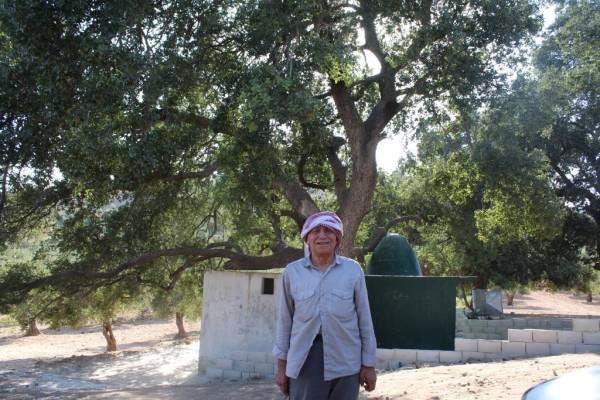

An interesting 2017 interview with an Alevi woman in Mabeta highlights that in the Ba'th years, some community members began to frequent Shi'a mosques and shrines elsewhere in Syria, such as Sayyida Zaynab (Damascus) & Jebel Zayn al-Abidin (Hama).
The hegemony in Afrin established by the PYD in 2012 created an opening from Alevis to enter public life. Community members served in various governance positions, for example an Alevi woman Hevi Ibrahim Mustefa was at one point the Afrin canton's co-chair president. Five communes, the lowest level of the DAANES governance structure, were organized in and around Mabeta, representing the Alevi community. While its unclear how much buy-in there was to the PYD's political project by the Alevi community as a whole, accounts by locals are quite emphatic that these years represented a revival of sorts in comparison to the decades under Ba'thist rule.
In September 2017 an 'Alevi Center' opened in the center of Mabeta with an event attended by PYD officials including Hevi Ibrahim Mustefa and Pir Comard Seto, a current Afrini Alevi religious leader (3rd photo on the right).
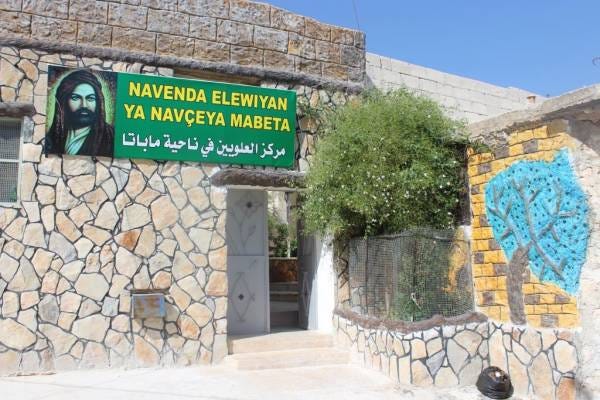
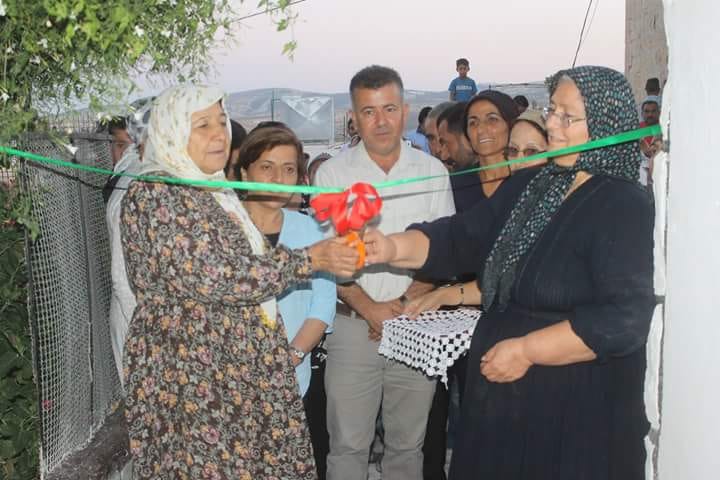
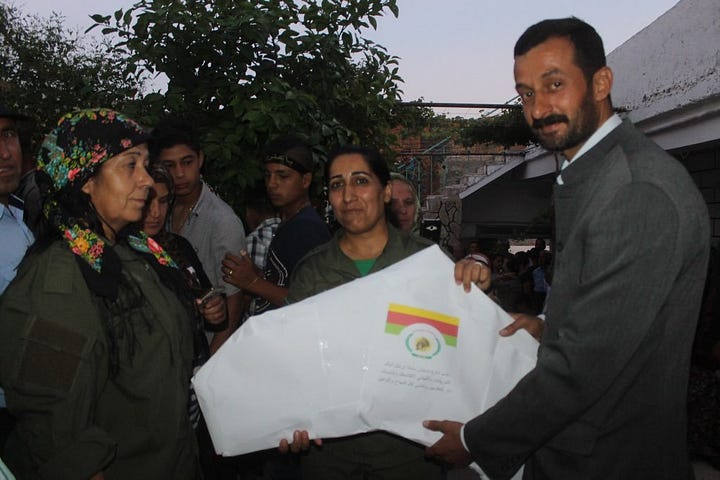
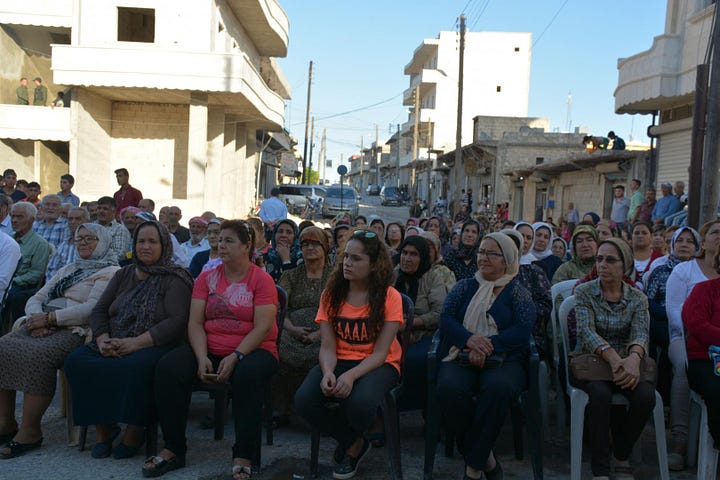
This new found openness contrasted with rising sectarian violence across Syria. According to local testimony published by Schmidinger (2019) “as early as 2015, people from Mabeta were no longer able to travel to Aleppo...merely having Mabeta stamped on your ID raised the risk of being suspected of being an Alevi.” Two years prior several Alevis from Mabeta were reportedly kidnapped by opposition militants on their way to Aleppo.
Given the mass displacement of Afrini natives caused by Turkey's invasion of the region in early 2018, it's unclear how many Alevis remain in Mabeta. Some have apparently stayed behind, as show in a Sept 2018 incident in which an Alevi teacher in Mabeta was accused by newly arrived IDPs from southern Syria of insulting Islam, causing protests and her arrest by armed factions.
As has been the case with those frequented by Sufis and Ezidis, Alevi shrines in Afrin have suffered desecration and destruction at the hands of the region's occupiers. The Af Ghiri shrine was desecrated and vandalized on multiple occasions in late 2018 and early 2019 (see photos below). The Ali Dede shrine and a nearby cemetery were destroyed by the Turkish military while building a hilltop military position during Olive Branch. While outside the Mabeta area, the shrine's name indicates clear Alevi origins. On 25 Aug 2018 it was reported that the grave of Dr. Nuri Dersimi in Hannan cemetery just east of Mabeta was vandalized by unknown assailants. Placards memorializing his role in the Kurdish national movement had been destroyed and removed.


The 2018 Turkish invasion and subsequent rule caused both a large exodus from Afrin and a forcing of heterodox local religions such as Alevism, in addition to Kurdish cultural life more broadly, underground. Given their shared name Alevis undoubtedly suffered due to non-locals associating them with the ‘Alawis of the Syrian coast and in turn the former Syrian regime. These trends began to reverse quite slowly in the years that followed, particularly following the February 2023 earthquake and the entrance into the region of the Barzani Charitable Foundation, the first significant contact with the region by outside Kurdish actors. As is the case with all of post-Asad Syria, it remains to be seen what the future holds for the Alevis of Mabeta and whether they will be able to return to something resembling the public life lived during the Afrin Canton years.



